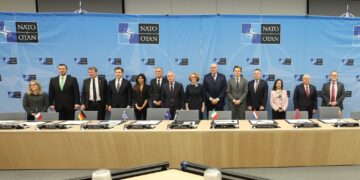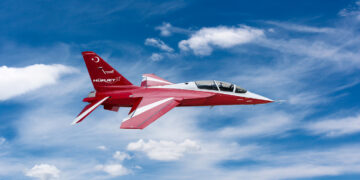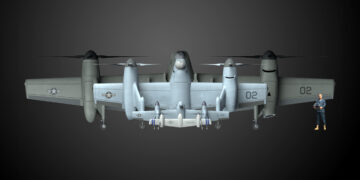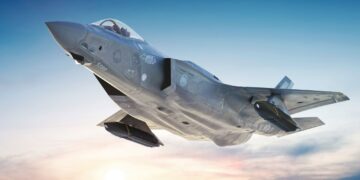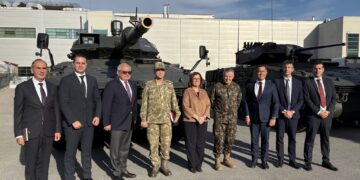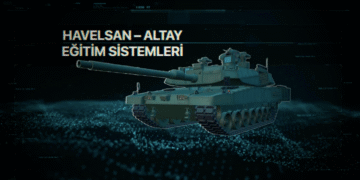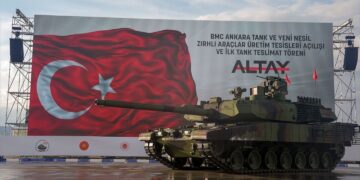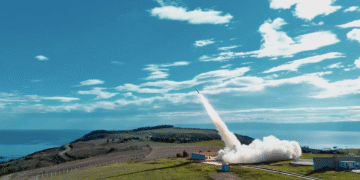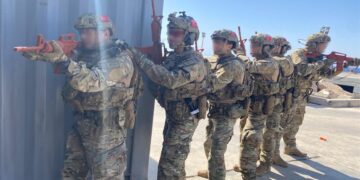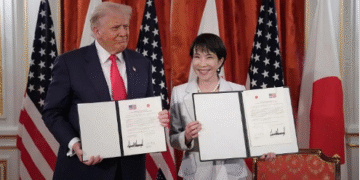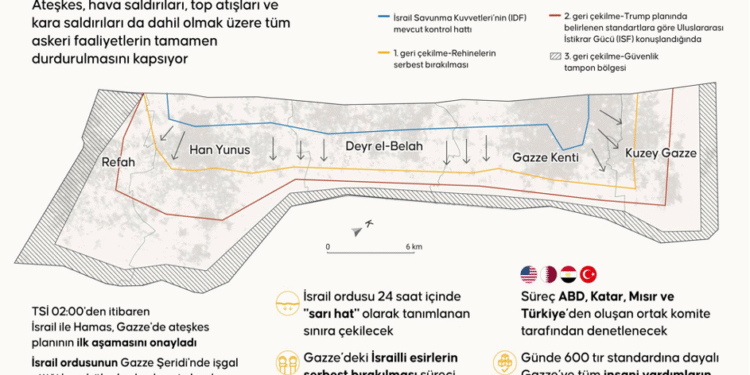“If you continue this nuclear arms race, the only thing you will be doing is picking up the rubble.”
Winston Churchill[1]
“The nuclear option is absolutely not an option. It is a one-way road to annihilation. We must avoid this dead end at all costs. Others are expanding their nuclear weapons and material inventories. Some continue to use the nuclear sword as a tool of coercion. We are also seeing signs of new arms races, including in outer space.”
UN Secretary-General António Guterres, February 24, 2025
As autumn approaches, the world draws near to a new year under the winds of both peace and war within global political and military security balances. We are facing a geopolitical reality: an era in which the flow of history is accelerating, uncertainty is deepening, and the world is undergoing a critical and highly delicate transition period—one that closely concerns all states, including Turkey. Therefore, it is of vital importance to analyze developments through a realist lens and to be prepared for the surprises of the future.
In this context, while the wars in Ukraine and Gaza continue, the U.S.–China trade wars have extended through the Korea Summit. However, the U.S. military buildup in the Caribbean Sea remains a source of concern. As a NATO member, Turkey hosted two historic allies—the Prime Ministers of the United Kingdom and Germany—in Ankara, and signed an agreement to purchase Eurofighter jets to strengthen its air power. At the same time, Turkey assumed a critical role by supporting President Trump’s Gaza peace initiative and taking on the status of guarantor country in the ceasefire agreement.
While Russia continued negotiations with the U.S. outside the usual U.S.–NATO frameworks through the Alaska ceasefire talks, NATO conducted a significant nuclear air exercise. In response to these developments, President Putin intensified missile and drone attacks on Kyiv and swiftly responded with the 9M730 Burevestnik (Storm Bird) Missile and Poseidon Torpedo.
Within the scope of these rapid developments, President Trump, as promised before the elections, has intensified his diplomatic efforts to end the Russia–Ukraine War, which poses a serious threat to world peace, as well as the ongoing Gaza War in the Middle East. In this context, although a temporary ceasefire has been achieved in Gaza, Prime Minister Netanyahu continues military operations under various pretexts. Thus, the future of Gaza and Palestine—and therefore the regional balance of power across the broader Middle East—has reached a critical crossroads.
In the Middle East, the ceasefire that brought an end to Israel’s attacks on Gaza followed the acceptance of U.S. President Donald Trump’s peace plan by all parties on September 29, 2025. Trump’s 20-point peace plan explicitly provides that Palestinians will continue to live in Gaza and that “Israel will neither occupy nor annex Gaza.” Much of the plan contradicts the goals of the far-right members of Israel’s ruling coalition, who seek Gaza’s permanent control by Israel as part of a “Greater Israel.”
As a second move, Trump planned a meeting in Hungary, following the U.S.–Russia Summit in Alaska, to end the ongoing Russia–Ukraine War. However, this meeting did not take place due to assassination allegations against Putin and claims that Russia refused to make any territorial concessions.
On Wednesday, the U.S. imposed sanctions on major Russian oil companies, accusing Moscow of lacking commitment to ending the war in Ukraine. In response, Russia conducted a large-scale nuclear exercise. Western diplomatic efforts for a ceasefire with Moscow have repeatedly failed. This demonstrates that despite the enormous costs Russia has borne since 2022, its strategic objectives in Ukraine remain largely unchanged. Despite growing economic, military-industrial, and demographic challenges, the war remains sustainable for the Kremlin in the foreseeable future. Russia continues to believe it can win a war of attrition and ultimately subjugate Ukraine, preventing it from aligning with the West until it is reintegrated into Russia’s sphere of influence.
President Trump, meanwhile, has grown increasingly frustrated with Vladimir Putin. Friendly talks, negotiation offers, postwar agreements—none have convinced the Russian leader to accept peace. On October 22, Trump’s anger boiled over. In his first major economic offensive against Russia since returning to the White House, he imposed sanctions on Rosneft, Lukoil, and 34 of their subsidiaries. According to the U.S. Treasury Department, the goal is “to weaken the Kremlin’s ability to generate revenue for its war machine and to prop up its weakening economy.”

The Kremlin, however, has not remained idle. Under its “Plan to Plunge Ukraine into Darkness,” as winter 2026 approaches, Russia aims to cripple Ukraine’s energy system through missile bombardments and drone attacks. Russian forces have intensified assault operations around Pokrovsk in an effort to capture the city. Geolocated footage published on October 31 and November 1 indicates that Russian forces have recently advanced into the central and southeastern districts of Pokrovsk.
Two new Russian weapons: the Burecestnik Missile and the Poseidon Torpedo

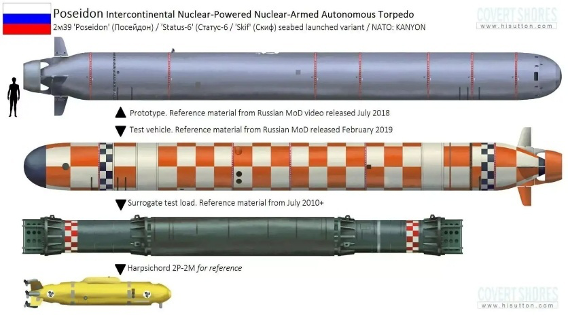
Tactically, rather than conquering Ukraine, the Russian Army aims to destroy it by launching air strikes against the power grid, central heating systems, and gas infrastructure as winter approaches. The goal is to render large areas in the country’s east uninhabitable, sabotage industry, and trigger mass migration.
Why, then, are Russia’s micro-attacks on Europe increasing? Moscow hopes to erode European support for Ukraine and expose American indecision.
The incident on the morning of 10 September marked the most serious attack on NATO territory since the alliance’s founding in 1949. Nineteen UAVs were launched—mostly from Belarus, where Russian forces operate freely. The drones penetrated deep into Polish airspace; some were shot down, while others crashed without causing casualties.
After months of intensive diplomatic efforts by U.S. President Donald Trump to bring Russia and Ukraine to the negotiating table, it appears that Trump has, for now, abandoned his attempts to end the war. Three days after announcing the test of the nuclear-powered Burevestnik missile, Moscow revealed that it had also tested the Poseidon nuclear-capable underwater unmanned vehicle. The second nuclear test, conducted within just one week, came as talks with Washington stalled because Moscow refused to agree to a ceasefire in Ukraine.
Trump defended his decision as an effort to keep pace with other nuclear powers such as Russia and China: “I think it’s appropriate for us to test while others are testing,” he said. Nevertheless, it will likely take several months before the United States resumes nuclear testing after a 33-year hiatus.
These new nuclear tests, signaling a clear escalation, reinforce the concern that the world—already in a perilous phase though not yet in a full-blown arms race—may be pushed further toward one, potentially triggering a domino effect. In our view, the world is rapidly re-entering an era of arms competition, potentially led by the United States, Russia, and China. This is the central argument of this article.
In this context, a Ukrainian drone attack ignited massive fires in the Russian city of Tuapse, engulfing a fuel depot and the city’s port in flames. The incident could disrupt Moscow’s fuel exports: a significant share of Russia’s crude oil and refined products reach global markets via the Krasnodar port in the country’s south. In recent months, Kyiv has intensified its strikes on Russian oil and energy infrastructure that sustain the Kremlin’s war effort.
A third strategic development is the tangible progress in diplomatic rapprochement between Turkey and Europe, along with the deepening of defense and security cooperation. The past week was a pivotal one for Turkey’s relations with Europe. At the start of the week, U.K. Prime Minister Keir Starmer reached an agreement with Turkey for the sale of 20 Eurofighter jets. The visit of German Chancellor Friedrich Merz to Ankara the following day signaled a more pragmatic era in EU–Turkey relations.
Indeed, Turkey and the United Kingdom took a significant step toward securing long-discussed fighter procurement by signing a memorandum enabling Ankara to operate Eurofighter Typhoon combat aircraft. A historic cooperation agreement was signed between President Recep Tayyip Erdoğan and Prime Minister Starmer for the supply of 20 new Eurofighter Typhoons. In addition, Turkey will acquire 12 used aircraft each from Qatar and Oman, bringing its total to 44 Typhoons.
Starmer emphasized that the deal will “both deepen NATO security and expand bilateral cooperation in the defense industry,” adding: “Turkey and the U.K. may sit at opposite ends of Europe, but we are working together more closely than ever. This historic agreement is a win for British workers, a win for our defense industry, and a win for NATO security.”
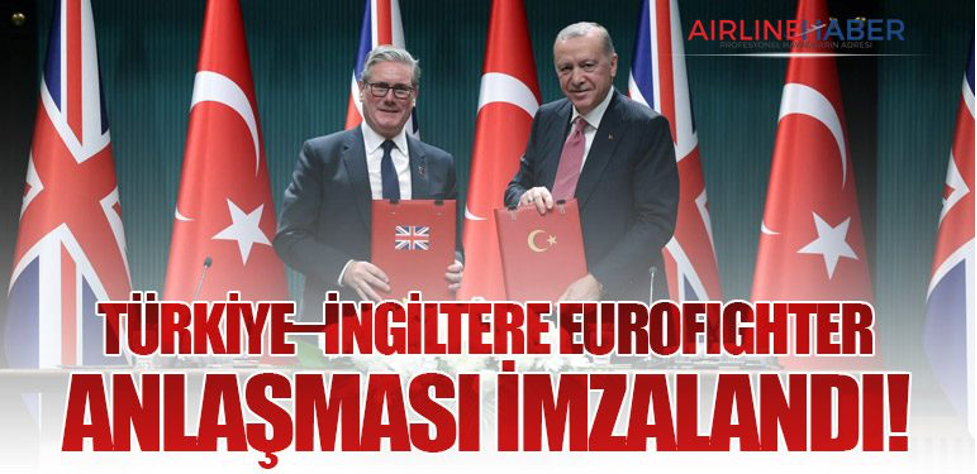
Turkey’s £8 billion Eurofighter Typhoon acquisition aligns Ankara’s drive to modernize its air power with Britain’s post-Brexit ambition to re-establish itself as a global defense export hub. Both parties described the agreement as a step toward “strengthening NATO solidarity.” For the U.K., the deal is part of a strategy to expand defense partnerships beyond the European market. For Turkey, the purchase serves as an interim solution to modernize its air force until the indigenous KAAN fighter project reaches maturity. Given Turkey’s aging F-16 fleet and growing security risks in the Aegean and Eastern Mediterranean, this need has become increasingly urgent. London views the sale as one of the most tangible economic and diplomatic successes of the post-Brexit period. Beyond commercial value, Britain sees Turkey as a “security corridor” extending toward the Middle East, the Caucasus, and Central Asia — a region critical to U.K. energy security and intelligence architecture. Thus, the Eurofighter deal represents not only a commercial exchange but also a geopolitical investment.
In short, the Eurofighter issue can also be interpreted as an element of competition between Europe and the United States — or, from Ankara’s perspective, as a diplomatic lever to accelerate defense cooperation with Washington. In our view, this historic agreement — a renewal of trust with Europe for a country that has operated U.S. warplanes since acquiring Spitfires 80 years ago — reinforces Turkey’s integration into NATO and regional security structures. It also demonstrates that Ankara is acting as a confident, measured, and indispensable force multiplier in emerging strategic equations.
As the Financial Times noted, the agreement underscores Europe’s perception of Turkey as a “shield” against Russia and instability in the Middle East, while also acknowledging Turkey’s urgent need for new fighter aircraft as NATO’s second-largest army.
Immediately after the U.K.–Turkey fighter jet deal, Chancellor Merz’s visit to Ankara reflected the shifting global power landscape. Turkey’s growing economic and military capacity over the past two decades, along with its major contributions to NATO and European security, have elevated its importance as a strategic partner. Turkey’s expanding defense industry and role as a facilitator in resolving regional conflicts make it one of Germany’s most valued security partners. A fourth major development concerns the uncertainty surrounding the scale of U.S. military operations in the Caribbean Sea. At the end of October, U.S. Defense Secretary Pete Hegseth — whom President Trump refers to as his “war minister” — announced that four smuggling vessels had been sunk in the eastern Pacific, killing 14 people. International law experts have raised serious concerns about the legality of these actions. Nevertheless, Congress has effectively granted Trump broad authority, as Senate Republicans blocked a Democratic bill that would have required legislative approval for military strikes against drug cartels. The deployment of a large U.S. naval force to the Caribbean raises questions about whether this buildup is truly limited to counter-narcotics operations.
Reports suggest that Washington is preparing to strike targets in Venezuela identified as military facilities linked to drug trafficking. The Trump administration has deployed significant military assets off the Venezuelan coast — a chilling signal of possible regime-change intentions. The Pentagon recently announced that the U.S. Navy’s largest aircraft carrier, the USS Gerald Ford, will redeploy from Europe to join a task force that includes destroyers armed with Tomahawk cruise missiles, B-1 and B-52 bombers, and special operations helicopters. U.S. officials have left little doubt that this could have deadly consequences for President Nicolás Maduro. The fates of regional leaders such as Chile’s democratically elected Marxist president Salvador Allende, overthrown in a 1973 military coup, and Dominican Republic dictator Rafael Trujillo, assassinated in 1961, serve as stark warnings. After the CIA-backed coup that ousted Guatemala’s elected president Jacobo Árbenz in 1954, the country plunged into a 30-year civil war, costing roughly 150,000 lives and leaving 50,000 missing. The plot to overthrow Fidel Castro included the failed 1961 Bay of Pigs invasion, organized by the CIA and executed by Cuban exiles. Since the 1962 Cuban Missile Crisis, the U.S. has not deployed such a large naval presence in the region — and many fear that Maduro’s fate could now be at comparable risk.
Peace in Gaza and Israeli Attacks in the Middle East
In October, when a ceasefire was achieved in Gaza, it was met with great fanfare and relief from all sides. Celebrations erupted in the rubble-filled streets of Gaza City, Israeli hostages and Palestinian prisoners returned to their families, and Donald Trump was praised for his role in brokering the deal. After two years of brutal war, good news had finally arrived. Crucially, unlike the ceasefire reached in January—which Israel had unilaterally abandoned—the latest ceasefire was part of a comprehensive framework: U.S. President Donald Trump’s 20-point Gaza peace plan, largely based on former UK Prime Minister Tony Blair’s efforts to resolve the Israeli-Palestinian conflict.

The plan, in addition to ending the conflict, outlines a roadmap for transforming the region, and its final points—albeit in vague terms—call for a “credible path” toward Palestinian self-determination. The plan is full of fairly rational components. Stage 1, largely implemented, called for halting hostilities, the release of Israeli hostages and Palestinian prisoners, and the withdrawal of Israeli forces from some parts of Gaza. While these achievements certainly deserve celebration, the later stages of the plan—including the disarmament of Hamas, the reconstruction of Gaza, and ultimately the rebuilding of Palestine—remain uncertain.
After signaling support for U.S. President Donald Trump’s proposed peace plan, Israel and Hamas began indirect talks in Egypt aimed at ending the war in Gaza. The U.S.-mediated talks were held in Sharm El Sheikh, the Red Sea resort town of Egypt, one day before the second anniversary of Israel’s assault on Gaza. The talks aimed to bridge the gaps between Israel and Hamas and clarify the details of implementing the first phase of Trump’s plan. This phase included the release of hostages and Palestinian prisoners, as well as an immediate ceasefire.
The Peace Summit in the Middle East, held in Sharm El-Sheikh, Egypt, took place on October 13 with the participation of heads of state from 31 countries. Although hosted by Egypt, it can be said that the summit was the result of President Donald Trump’s recent diplomatic initiatives regarding the Middle East. Indeed, while Washington played a key role in the signing of the ceasefire in Gaza, Trump’s most important regional partners in this process were Turkey, Egypt, and Qatar.
This was reflected in President Trump’s speech at the signing ceremony. Trump separately thanked President Recep Tayyip Erdoğan, Egyptian President Abdel Fattah el-Sisi, and Emir of Qatar Sheikh Tamim bin Hamad Al Thani for their significant efforts. In his statement after the prisoner exchange and ceasefire agreement that went into effect on October 10, Trump made the following remarks about President Erdoğan:
“Turkey was fantastic. President Erdoğan was fantastic, he was really very helpful. Because he is someone who is highly respected. He has a very strong country and a very strong army.”
Trump continued: “I don’t know why, but I like tough people more than soft and easy ones. I think it’s a personality issue. But this gentleman from a place called Turkey actually has one of the strongest armies in the world—much stronger than he shows. If you look at the recent conflicts, he was at the forefront and he was winning. He did win. But he never asks for praise, he doesn’t want anything, he just wants to be left alone. He’s a tough nut, but he became my friend and whenever I needed him, he was always there.” Trump added: “Because he is a difficult person, when NATO has a problem with him, they call me and say, ‘Can you do us a favor and talk to Erdoğan?’ So I talk to him, and he never lets us down. He’s a great person.”
Turning to Erdoğan, Trump said: “So I want to thank you for your friendship.” When asked whether Erdoğan and other leaders could also help resolve the Russia-Ukraine conflict, Trump replied: “Erdoğan might. He is respected by Russia. I can’t say about Ukraine, but (Russian President Vladimir) Putin respects him.”
Meanwhile, according to the dominant view in the Western press, Ankara “proved itself once again in the Middle Eastern chessboard against Israel and its Arab rivals” by persuading Hamas to accept Trump’s 20-point peace plan.
Point 15 of Trump’s Gaza plan states that the U.S., “in coordination with Arab and international partners, will establish a temporary International Stabilization Force (ISF) to be immediately deployed in Gaza.” As long as the ceasefire is not solid, the creation and deployment of such a force will not be possible. Potential participants will not send troops to use force to disarm Hamas.
Following these developments, three main dynamics could encourage Gulf countries to move toward a new diplomatic framework and regional alignment: transforming existing engagement in Syria into strategic gain, the personal relationships Gulf monarchies have developed with Trump, and a shift in regional threat perception in favor of Israel.
After the Trump administration put forward the “20-point plan” and pressured the Israeli government to accept it, the heavy pressure shifted to Hamas. Hamas immediately announced its willingness to comply, declared it would not seek to participate in governing Gaza after the war, but absolutely rejected disarmament, calling resistance “a national right against illegal occupation.” This alone signifies a structural and irreconcilable contradiction between Hamas and the U.S.-Israel bloc, and it also means that once Stage 1 of the ceasefire—the “prisoner exchange”—is completed, conflict in Gaza will inevitably resume.
Heavily armed Israeli forces, which still control 53% of Gaza’s territory, will launch a final offensive against Hamas’s remaining forces, and it is even possible that they may receive support from the U.S. military.
The silencing of weapons, opening of humanitarian corridors, and initiation of the prisoner exchange process have undeniably been vital gains for civilians. However, even before the ink dried on the agreement, deep skepticism prevailed among both analysts and the people of the region.
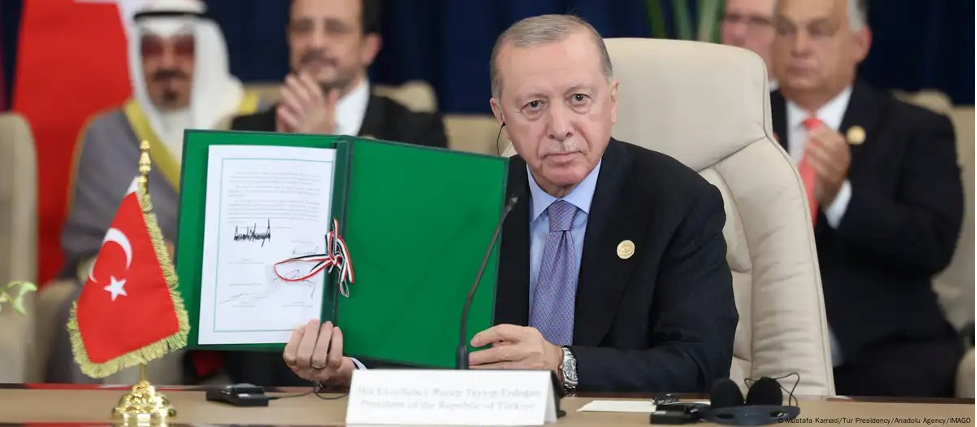
While the administration of U.S. President Donald Trump sees the peace deal signed between Hamas and Israel in the Gaza Strip as the key to a new era in the Middle East, Israel’s steps threatening the peace have increased Washington’s concern. The tension between the U.S. and Israel, which peaked after the Israeli parliament voted on Wednesday to approve the annexation of the West Bank, continued yesterday.
According to the realist theory advanced by Professor John J. Mearsheimer, one of the most important representatives of the realist school in international relations, states primarily seek to maximize their security and national interests. In this context, for Israel, a ceasefire is not an absolute goal but a strategic instrument. The core motivation behind Israel’s acceptance of the current deal is the realization that its goal of completely destroying Hamas militarily does not reflect realities on the ground, and that the operation has completely lost international legitimacy.
Thus, the agreement provides Israel with a tactical pause, a chance to reduce international pressure, rebuild its worn-out military capacity, and most importantly, retrieve Israeli hostages who have been a major source of public pressure. A critical question arises at this point: After achieving its primary goal of rescuing hostages, will Israel set aside the agreement and return to its previous plans?
Mearsheimer’s analytical framework leans toward answering yes. According to him, Israel’s ultimate objective is not a two-state solution or permanent peace, but the realization of the “Greater Israel” project. U.S. Vice President JD Vance and other American representatives, during their visit to Israel on Tuesday, said they were optimistic about the fragile ceasefire in Gaza and noted that progress was going better than expected. Despite the recent deployment of around 200 U.S. soldiers to Israel, Vance emphasized that the troops would not be stationed inside Gaza. However, officials stated that they had already begun designing “what an international security force for the region might look like.” Countries expected to take part reportedly include Turkey and Indonesia. On the stage where the speech was delivered, the flags of Jordan, Germany, the United Kingdom, and Denmark were displayed.
Israelis celebrated the release of hostages held by Hamas in a Tel Aviv square on October 13. U.S. Secretary of State Marco Rubio said in a statement after a bill that would apply Israeli law to the West Bank received preliminary approval in the Israeli Parliament (Knesset) that this move “could jeopardize the peace plan in Gaza.” According to Israeli media, Israel long opposed Turkey playing a role in Gaza and strongly resisted it. However, due to pressure from Trump and the recent rapprochement in Turkey–U.S. relations, Trump has trusted Erdoğan and expects him to “restore order” in the Middle East. Turkey’s ability to exert pressure on Hamas ensured the signing of the agreement. President Erdoğan said: “I appreciate the effort and leadership shown by U.S. President Mr. Trump to stop the bloodshed in Gaza and to achieve a ceasefire. As Turkey, we will continue to contribute to the process to establish a just and lasting peace acceptable to the parties.” President Recep Tayyip Erdoğan stated after the cabinet meeting held on October 15, 2025, that their struggle will not slow down until an independent State of Palestine is established. Erdoğan expressed satisfaction that a ceasefire had taken effect in Gaza and said Turkey will prioritize the entry of humanitarian aid.
A long-awaited ceasefire between Israel and Hamas was finally achieved, but tensions have already begun to take root. With all the old obstacles in Trump’s twenty-point peace roadmap, the end of the conflict remains uncertain. Since the ceasefire came into effect, the death toll has reached 88 and the number of wounded 315. It was also reported that the bodies of four people were recovered from under the rubble in the last 24 hours. Thus, since Israel launched its attacks on October 7, 2023, the number of people killed in the Gaza Strip has risen by 5 to 68,234, and the number of wounded has risen to 170,373. Israel’s request is the first-stage demand of the U.S.-Israel side, while the U.S. request is the second-stage demand. Only a week after Israeli Prime Minister Netanyahu and Trump jointly declared in Jerusalem that “the Gaza war is over” and convened a flashy “Egypt Peace Summit,” Trump hastily contradicted himself, backed away from the promise of peace, prepared to restart the fighting in Gaza, and even threatened to deploy the U.S. military to the field personally. Israel is on alert, leaving substantial forces in Gaza, and the parties accuse each other of failing to comply with the first-stage provisions of the ceasefire. With this display of force by Trump on behalf of Israel, it appears the Gaza war, which has stretched on for two years, is far from over.

Israeli Prime Minister Benjamin Netanyahu ordered “urgent and powerful strikes” in the Gaza Strip, which led to the deaths of 104 Palestinians overnight. He announced the ceasefire would resume on Wednesday morning. This was the deadliest incident in Gaza since mediation between the two sides on October 9. Israel and Hamas had previously accused each other of violating the fragile ceasefire, but both parties later reiterated their commitment to the agreement.
Israel announced that Hamas fighters killed two of its soldiers in Rafah and launched a series of attacks earlier this month that resulted in at least forty-five deaths. Israeli military forces also killed Palestinians who were allegedly on the Israeli side of the negotiated withdrawal line that was in the final stages of being drawn. Israel had earlier accused Hamas of violating the ceasefire terms by not returning the remains of the last deceased hostages by October 13. In response, Israel temporarily restricted the negotiated flow of aid into the Gaza Strip under the ceasefire. Israel’s airstrikes exposed the fragility of Trump’s “peace plan.” Without international support, the plan risks complete collapse. According to Israel, this wave of violence occurred because Hamas still fired on Israel Defense Forces units in the Rafah area, which remains under Israeli control, resulting in the death of an IDF reservist. Hamas denied involvement in the incident. Israel responded with additional strikes on Gaza City and Khan Younis. Because both sides interpret violations in ways that favor their interests, the vague nature of the ceasefire leaves wide room for miscalculations and opportunism.
Israel has made it clear it will not move to the next phase until Hamas returns the bodies of the deceased hostages; Hamas is struggling to meet this condition. Hamas accuses Israel of using the hostage issue as a pretext to maintain military control. Meanwhile, Gaza’s infrastructure lies in ruins, the humanitarian situation continues to deteriorate, and basic services are collapsing. The population, traumatized by two years of war, faces severe shortages of food, water, and medicine, while aid convoys are subject to political bargaining and intermittent blockades. Beyond Gaza, violence continues to spread in the West Bank. In recent days clashes between Israeli forces and settlers and Palestinians have intensified. This parallel escalation — which the Israeli right-wing government does not discourage and may even enable — highlights the limited scope of the current ceasefire and shows how easily the conflict can expand again. The Trump administration has tried to sustain the ceasefire through high-level visits by Jared Kushner, Steve Witkoff, JD Vance, and Marco Rubio. It also deployed 200 troops to a monitoring center and continues to apply pressure to both sides. While this engagement may be positive and demonstrates American intent, it alone is not enough to prevent renewed cycles of conflict. As a result, the administration’s statements continue to call for calm, but offer little in the way of accountability. The newly established monitoring center lacks authority to verify compliance or enforce it. Egypt and Qatar continue their mediation roles, but their influence is waning in this environment of uncertainty.
For the ceasefire to become a sustainable framework, it must be reinforced internationally, not only by U.S. pressure and the vague framework of Trump’s 20 points. Regional and international actors should implement independent monitoring, clear timetables for reconstruction and withdrawal, and binding guarantees for security and humanitarian access. Without these elements, the situation will oscillate between calm and cycles of violence and ultimately lead to a new wave of war. Under the ceasefire terms the Israeli army withdrew from parts of Gaza, but still occupies about 53% of the area. In a future scenario where the army maintains control over large tracts of land, the Israeli settler movement might try to pursue a strategy similar to the game plan that has worked well for them in the West Bank. Settlers could attempt to establish small outposts in territory under Israeli control that currently has relatively few Palestinians and large piles of rubble on which construction could be undertaken. The Israeli settler movement was a key spoiler during the Oslo Accords process and worked continuously to undermine the opportunity to build a Palestinian state in the West Bank. The movement built so many settlements and supporting infrastructure successfully that a territorially contiguous Palestinian state in the West Bank has become almost impossible. Moreover, Netanyahu, as he boasted, was quite successful as a spoiler during the Oslo implementation process. As new peace efforts begin, the reality is that the current Israeli government is run by politicians who take pride in having derailed previous peace processes and prevented the establishment of a functioning Palestinian state. In particular, Hamas was another major spoiler that undermined the Oslo Accords and remains the most important Palestinian actor in Gaza, which is another source of skepticism about the future.
The Russia–Ukraine War Is Dragging into Its Fifth Year in the Shadow of Missiles and Aircraft
“We could only solve our problems by cooperating with other countries. It would be paradoxical not to cooperate. Therefore, we had to bring an end to the Iron Curtain, change the nature of international relations, rid them of ideological conflicts, and above all put an end to the arms race.”
Mihail Gorbaçov[38]
“There is talk of sending NATO forces to Ukraine. But [in the past] we remember the fate of those who sent troops. Now the consequences will be much more tragic for the interveners. We also have weapons that can strike targets on their territory. This truly threatens a conflict with nuclear weapons and therefore the destruction of civilization.”
Vladimir Putin
The Russia–Ukraine War remains uncertain. Ukraine has refocused on the war after the U.S. president secured a ceasefire and hostage release agreement in Gaza. The Alaska summit between Trump and Putin did not bring the promised benefits of peace to the region’s peoples. New sanctions were announced a day after the planned summit between U.S. President Donald Trump and Russian President Vladimir Putin was called off. Trump told reporters he canceled the meeting because it “didn’t move toward him.” The cancellation of the Trump–Putin meeting and the visit of the NATO Secretary General have renewed questions about Washington’s role in ending the war in Ukraine. As is evident from Trump’s approach to the war in Gaza, one can say a big deal is unlikely. According to NATO Secretary General Mark Rutte, Russia is currently allocating 40% of its budget to a war economy and is expected to produce at least 1,500 tanks, 3,000 armored vehicles, and hundreds of Iskander missiles just this year. China is also rapidly expanding its military capabilities, including its nuclear arsenal. The President of Russia said: “We are closely following Europe’s increasing militarization… We cannot ignore what is happening. We have the right to do this for our own security.” In Washington, Trump met with Ukrainian President Volodymyr Zelensky and said, “I hope we can end the war without thinking about Tomahawks,” while also saying the U.S. needs Tomahawks and “many other weapons we sent to Ukraine.”
This war is the deadliest and most consequential conflict in Europe since World War II. Since Ukrainian airports remain closed, those traveling into the country must take at least a fourteen-hour train or car journey from Poland to Kyiv. Technology is so advanced and its destructive power so great that Western partners are flocking to Ukraine to witness and invest in the future of modern warfare. Ukrainian sources say the Trump administration is in the early stages of negotiating a $50 billion, five-year deal in which both sides would produce ten million drones per year and double Ukraine’s projected production for 2026. President Putin’s red-carpet welcome in Anchorage symbolized Russia’s return to the international stage and the West’s inability to isolate Moscow. On the other hand, it must be remembered that the Kremlin leader has previously not ruled out changes to the nuclear doctrine, the document that sets the conditions for Russia’s use of nuclear weapons. Putin said, “This doctrine is a living instrument and closely watches what happens in the world around us, and we do not exclude making changes to this doctrine. This also concerns nuclear tests.” He warned European countries supporting Ukraine: Russia has “far more [tactical nuclear weapons] than Europe, even if the U.S. brings its own weapons.” “Europe does not have an advanced [early warning system],” he added. “In that sense they are more or less vulnerable.” With this statement he previously signaled openness to nuclear testing.
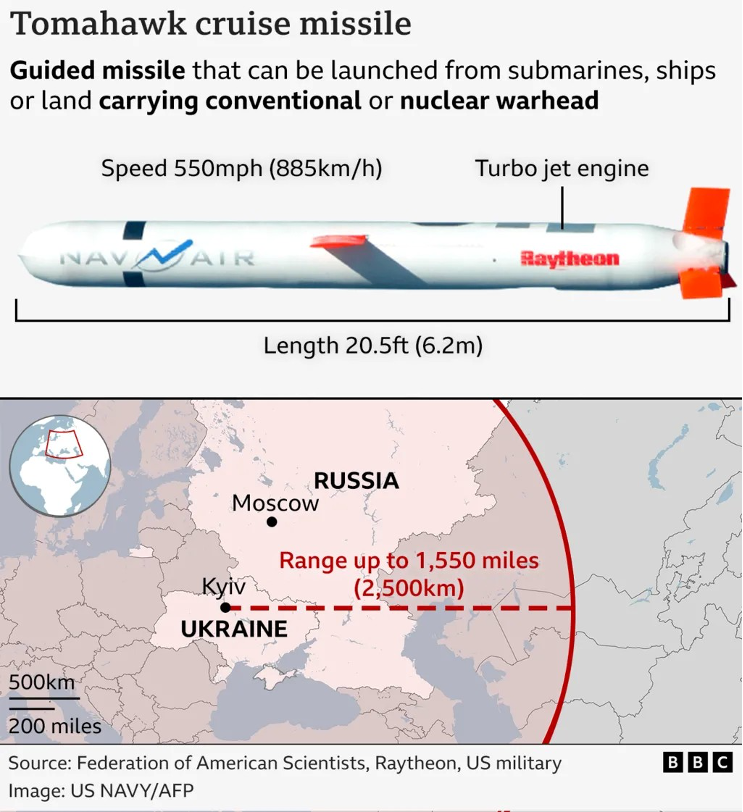
Responding to Trump’s “paper tiger” remark, Putin, implying the words might be ironic, replied, “If we are not uncomfortable fighting the entire NATO bloc, but we are paper tigers, then what is NATO?” As the U.S. nears a decision to supply Tomahawk missiles to Ukraine, the Kremlin is sharpening its rhetoric to deter U.S. President Donald Trump. Dmitry Peskov, spokesperson for Russian President Vladimir Putin, said the Tomahawk issue has caused “extreme concern” in Moscow and that the war has entered a “dramatic moment” of escalating tensions on all sides. Former Russian President Dmitry Medvedev led a thinly veiled nuclear threat at Trump: “It has been said hundreds of times, in a way even a man studded with stars could understand, that it is impossible to distinguish a nuclear Tomahawk missile from a conventional missile while in flight,” he said. “The launch of these missiles could end badly for everyone. And most importantly, for Trump himself.” Meanwhile, it has been reported that the U.S. will provide Ukraine with intelligence on long-range energy targets in Russia. Western, and especially U.S., intelligence in the form of satellite imagery and other surveillance data is thought to be a major aid in allowing facilities within Russia’s borders to be accurately targeted. Focusing on energy targets such as oil refineries could allow Ukraine to further advance its already successful operation of hitting 21 of 38 refineries with long-range drone strikes. This situation has led to fuel shortages in some regions of Russia. On some days, daily production is estimated to have fallen by one-fifth.
NATO Nuclear Alert Exercise
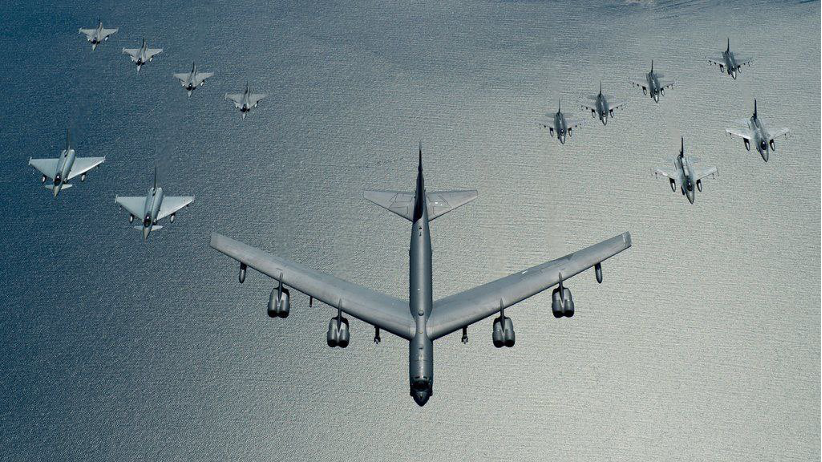
Fourteen NATO countries, including Germany, are completing this year’s “Steadfast Noon” nuclear war exercise today (24 October). The “Steadfast Noon” exercise, held every year in October, simulates a possible attack using U.S. nuclear weapons stored in Europe. Jet aircraft belonging to the German Air Force may also be used as carriers or launch aircraft. As an indication of the growing willingness to take part in a nuclear war in Europe, Finland and Sweden — the new NATO members — are participating in the exercise for the first time this year, while Denmark is providing a base for the exercise for the first time as well.
The German government is currently spending billions of euros to reconstruct the Büchel Air Base in the Eifel region so that U.S. F-35 fighter jets can be deployed there in the future together with the new B61-12 type nuclear bombs. At the same time, debates continue regarding a European nuclear shield independent of the United States. In addition to the nuclear shield provided by France, a German nuclear shield based on German nuclear weapons is also being discussed.
While nuclear sharing training and security are being maintained, the debates over creating an independent European nuclear shield — or alternatively purchasing a so-called “German bomb” — continue. Under current conditions, a European nuclear shield could be provided by France. After the latest German-French Ministerial Council meeting held in Bregançon on 29 August, Paris and Berlin announced that a “strategic dialogue” would be launched on this issue; the dialogue was to be conducted by the French Presidency and the German Chancellery, with the participation of both countries’ foreign and defense ministries. So far, no agreement has been reached because Germany insists on having some degree of say over the French nuclear forces — a demand France firmly rejects.
Russia has responded to NATO with its own nuclear exercise. During the exercise directed by Putin from the Kremlin, it was confirmed that a Yars intercontinental ballistic missile was launched from the Plesetsk Space Base in northern Russia, and a Sineva ballistic missile was launched from the Bryansk nuclear submarine in the Barents Sea. Russia’s exercise took place one week after NATO conducted its own nuclear deterrence exercise, “Steadfast Noon.” While the Sineva ballistic missile was fired from the Bryansk submarine into the Barents Sea, it was reported that Tu-95MS long-range bombers launched air-fired cruise missiles.
Russia, however, claimed that nothing has changed. Kremlin spokesperson Dmitry Peskov stated: “The United States is regularly transmitting online intelligence to Ukraine. It is obvious that all the infrastructure of NATO and the U.S. is being used to collect and transfer intelligence to the Ukrainians.”
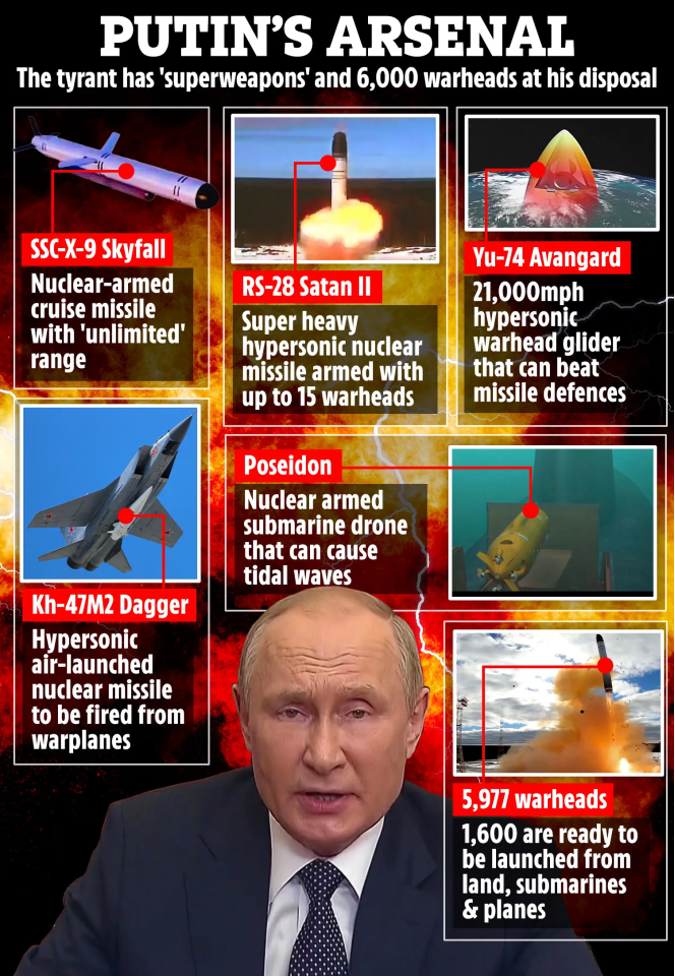
Following the increased pressure on Russia by Ukraine’s Western allies — as the war enters its fourth winter — Russia has intensified missile strikes on Kyiv. The Ukrainian Air Force announced that it downed four of the nine missiles and 50 of the 62 drones launched in Russian attacks across Ukraine. Casualties were reported in the capital Kyiv and the Dnipropetrovsk region.
U.S. President Donald Trump, who has not fully severed ties with Moscow, stated that he would meet with Russian President Vladimir Putin if an agreement to end the war in Ukraine could be reached. Trump said: “I would need to know that we are going to make a deal. I’m not going to waste my time.”
Tactically, the ongoing 2025 Russian troop deployments and various statements from the Kremlin indicate that Moscow’s primary objective is to capture the remaining towns in Donetsk, of which Ukraine currently controls about 25 percent of the region. Russia is estimated to be losing 100–150 soldiers for every square kilometer of territory gained in 2025. The war in Ukraine has become Russia’s second deadliest conflict of the past century, with total Russian losses approaching one million — a figure rapidly nearing the combined total of all Russian and Soviet war casualties since World War II.
Despite these heavy losses, the past three and a half years do not appear to have fundamentally altered the Kremlin’s political goals or strategic calculations. Current developments suggest that Russia can continue the war in Ukraine for at least another two to three years. In the face of unprecedented Western sanctions, the Kremlin has offset the collapse of foreign investment through massive, state-backed spending on its military–industrial complex. Technocratic governance, flexible supply chains, low debt levels, support from China, Iran, and North Korea, and stable energy revenues have allowed Russia to maintain both its military operations and social expenditures. Neither prolonged recession nor slow economic growth seems likely to destabilize Putin’s regime.
From a military–industrial standpoint, Russia’s equipment losses in Ukraine are unprecedented in the post-Soviet era. Since February 2022, the Russian army has lost more than 3,000 tanks — exceeding its pre-war active inventory — along with large numbers of armored personnel carriers, artillery, rocket systems, helicopters, and naval vessels. As domestic drone production continues to expand, Russia now has the capacity to manufacture around 30,000 Shahed-type unmanned aerial vehicles per year, with the potential to double that number by 2026. Russia is expected to launch more than 2,000 drones per salvo on a regular basis by autumn 2025.
Although Russia has suffered nearly one million total casualties to date, the Kremlin remains committed to its ambitious plan to expand the Russian army to 1.5 million active personnel — a goal set by President Putin in a September 2024 decree, which would make the Russian Armed Forces the second largest in the world after China. To this end, the Kremlin launched the largest spring conscription drive in 14 years in 2025, drafting 160,000 new recruits.
Taking these factors into account, developments indicate four most likely scenarios for the course of the war:
- A Russian breakthrough leading to the collapse of the Ukrainian army
- A prolonged low-intensity conflict
- A ceasefire
- A peace agreement
The summary evaluates the likelihood of each scenario and the strategies Ukraine and the West could adopt to maximize favorable outcomes. In every scenario, shifting the balance and ending hostilities will require substantial, sustained investment in the Ukrainian and European defense industries — to preserve Ukraine’s frontline forces, defend cities against missile and drone attacks, and conduct long-range strikes on Russian territory.
In the Ukraine war, however, Trump’s influence remains minimal. For the past nine months, he has oscillated between attempts to intimidate Putin and then Zelensky, but neither effort appears to have had any meaningful effect.
Developments in Turkey–Europe Strategic Defense and Security Cooperation: Eurofighter Fighter Jet Agreement
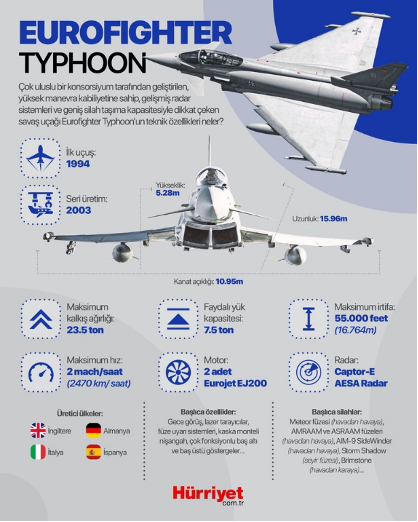
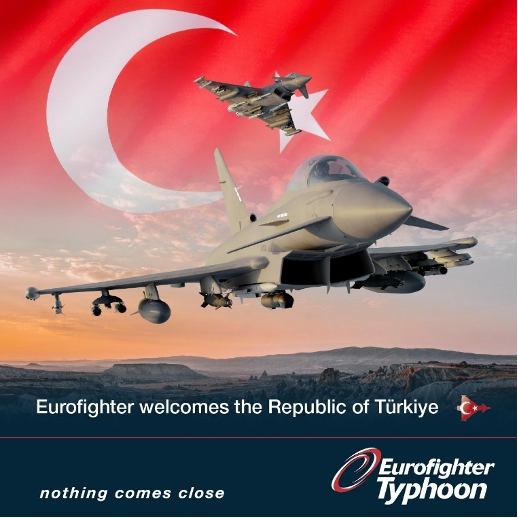
Turkey is nearing the conclusion of months-long negotiations regarding Eurofighter aircraft procurement. On 23 July, two significant steps were taken in Turkey’s process of acquiring Eurofighter Typhoon fighter jets. The Turkish Minister of National Defense, Yaşar Güler, and the UK Secretary of State for Defence, John Healey, signed a memorandum of understanding in Istanbul that recognized Turkey as a Eurofighter user. On the same day, the German publication Der Spiegel reported that Berlin had approved the sale of the fighter jets to Turkey. This was subsequently confirmed by German authorities. During his visit to Ankara, German Foreign Minister Johann Wadephul met with Turkish Foreign Minister Hakan Fidan and made statements regarding the Eurofighter program. Wadephul said, “Shipments to Turkey could begin soon.” He emphasized Germany’s desire to develop defense cooperation with Turkey, describing Turkey as a reliable NATO ally. He added: “If Germany does not cooperate with a NATO ally, who will it cooperate with? There are no restrictions from Germany; on the contrary, it wants to cooperate with Turkey in every area.”
Turkey has taken a significant step to strengthen its air power until its indigenous fighter jet, KAAN, enters service in 2028. Agreements have been made to acquire 12 second-hand Eurofighter Typhoons from Qatar and Oman, while diplomatic efforts have accelerated for the procurement of 28 new jets from the Eurofighter Consortium.
This agreement is also an important step for Europe-NATO defense cooperation. Michael Schoellhorn, CEO of Airbus Defence and Space, one of Europe’s leading defense industry companies, stated: “The political debates regarding Germany’s export control are now behind us,” and noted that the German government has clearly expressed that it will not obstruct Eurofighter deliveries to Turkey.
As a country exporting defense products, Turkey continues to strengthen its global position while addressing gaps in its own defense capabilities. As is well known, Turkey has made significant progress in procuring the Eurofighter, a European-origin fighter jet. Although Germany initially resisted granting approval, it ultimately had to lift its objections in the near term. However, the delay caused Turkey to lose valuable time, and it now seeks to accelerate Eurofighter procurement. The goal is to establish a large fleet. Even if agreements are immediately signed with producing countries, delivery usually requires waiting due to production timelines. Therefore, Turkey is negotiating to acquire Eurofighters already in possession of Qatar, Oman, and the UK to expedite delivery.
During this visit, discussions on acquisitions with Qatar and Oman led some circles in Turkey to quickly start debates about “second-hand” jets. However, they lack information on the age or usage of the aircraft to be acquired. Experts consider these debates about “second-hand” jets to be unnecessary. Essentially, Turkey’s negotiations with Oman and Qatar should be seen as a form of “intermediation” or “transfer.” It is known that Qatar and Oman’s acquisitions are recent and the aircraft are almost unused.
Turkey–UK Defense Relations and Strategic Context of the Eurofighter Agreement
In recent years, the S-400 crisis between Ankara and Washington, the F-35 program exclusion, and threats of sanctions have made Turkey’s position in the Western bloc somewhat contentious. Nevertheless, relations with the United Kingdom have continued to develop steadily. Over the past five years, Turkey–UK relations have accelerated, and the Free Trade Agreement implemented in 2021 increased bilateral trade volume to $19 billion in 2024. The UK has become Turkey’s second-largest export market outside Europe. London supports Turkey’s structural transformation in renewable energy, defense industry, and digitalization through increasing annual direct investments. The UK-based defense company BAE Systems provides technical consultancy for the KAAN project, reflecting this trust concretely. Turkish defense companies have already begun integrating into UK supply chains. This demonstrates that the two countries have achieved an interest-based, rather than ideological, alignment.
From the perspective of a “new security architecture,” Turkey’s Eurofighter agreement with the UK represents a strategic move for both countries beyond mere aircraft trade. With this agreement, Ankara seeks to reduce its dependency on the United States while building a new security architecture with the Western axis. London, on the other hand, aims to regain influence lost after Brexit.
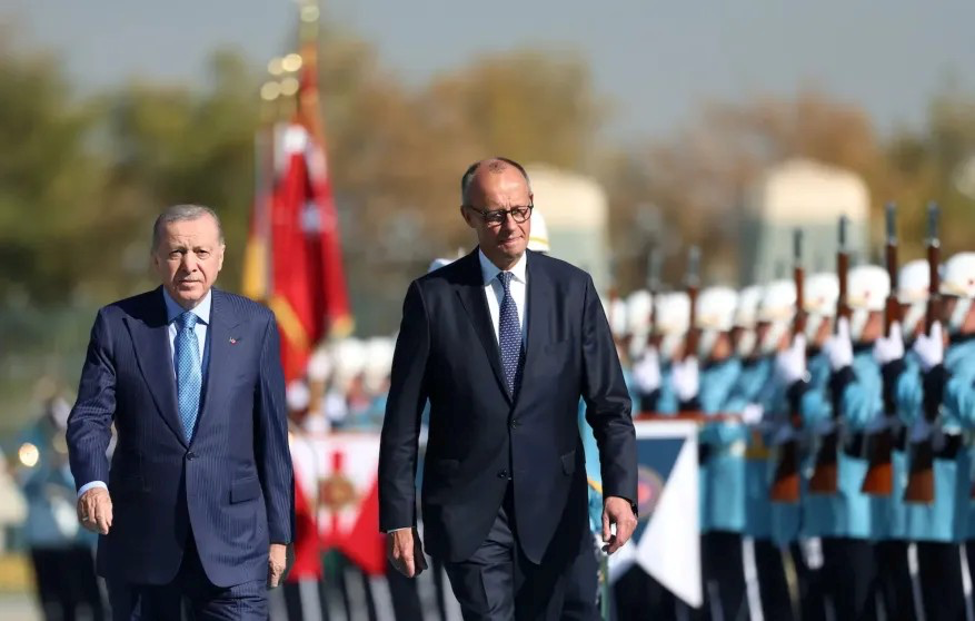
Following the meetings, President Erdoğan stated at the joint press conference that the inter-delegation discussions had finalized the implementation arrangements for Eurofighter Typhoon procurement: “I believe that this cooperation with the United Kingdom will also open the door for joint projects in the defense industry. I view this memorandum as a new symbol of our strategic relations as close allies.” UK Prime Minister Rishi Sunak said: “We are announcing a strategic partnership, the first bilateral cooperation framework between the UK and Turkey. This will deepen and enhance NATO security and increase bilateral cooperation in the defense industry.” Sunak emphasized the critical importance of collaboration between the UK and Turkey in facing today’s challenges: “This will allow our armed forces to work more closely together to deter threats and protect our national interests.”
Turkish Minister of National Defense Yaşar Güler announced that a total of 44 Eurofighters will be procured — 20 from the UK and 12 each from Qatar and Oman. Güler added: “The numbers may increase. The aircraft are expected to arrive early next year.”
From Germany’s perspective, politicians in Berlin, who until recently focused on trade, assumed reliance on the U.S. military support would suffice, and believed there was no serious threat as long as U.S. backing existed, have woken from a bad dream. Russia’s attack on Ukraine and the uncertain stance of U.S. President Donald Trump have jolted them. Because prolonged neglect of armament caused them to fall far behind militarily, they are now acting in panic. They have rapidly allocated large resources to defense, intend to reinstate compulsory military service to increase troop numbers, and are trying to regain alienated allies in their vicinity. Among the countries alienated through de facto arms embargoes, opposition to EU membership, and intervention under the pretext of democracy and human rights, Turkey is at the forefront.
What is clear is that Turkey’s potential inclusion in the EU’s €150 billion armament program SAFE is currently a significant agenda item for both countries. In this context, Federal Minister Merz’s announcement that Turkey–Germany strategic partnership will be enhanced, that strategic talks between foreign ministers will resume, and that defense ministers will meet indicates that the relationship will focus on war preparation topics.
Then the focus shifted to Venezuela. One day before the New York Times reported that the Pentagon planned to move against the cartels, Attorney General Pam Bondi announced that the US government was offering a $50 million reward for information that would lead to Maduro’s capture and accused him of “flooding” the US with cocaine. Trump alleged that Maduro ordered Tren de Aragua to “conduct hostile acts and irregular warfare against US territory.” Despite pressure from Trump’s political appointees to produce intelligence that matched the president’s claims, the intelligence community concluded the allegation was not true. Two senior career intelligence officials who oversaw the production of that estimate were immediately removed from their posts. When Democrats and some Republicans questioned the legality of instantly killing civilians who do not pose an imminent threat, Trump informed Congress he had determined the US was in “armed conflict” with unnamed “drug cartels” that trafficked drugs to the US and constituted an attack on the United States. Thus, drug traffickers were “unlawful fighters” who could be killed where found. US Southern Command chief Admiral Alvin Holsey resigned on Thursday amid concerns about the summary execution of civilians in air strikes.
US Naval Force in The Caribbean Sea And A Venezuela Anti‑Drug Operation: Is The Target Oil Or Regime Change?
In recent weeks US forces in the Caribbean, off Venezuela, have carried out at least eight strikes against vessels that Washington says were being used for drug trafficking, killing at least 38 people. In the most recent strike announced by Secretary of Defense Pete Hegseth, six people were reportedly killed on a vessel alleged to be used for drug trafficking on a so‑called “known drug smuggling route.” Would it satisfy Trump if a different member of Maduro’s regime replaced Nicolás Maduro and the president could declare victory? It appears that intimidation may be one of the main points of the operation: to show the world that the United States can do this to whomever it wants, whenever it wants. Even if there is no real war and the people killed (whose identities are not yet known) do not pose an immediate threat to other people’s lives. Records show the Trump administration prepared for this transformation of war and, since Trump took office — even earlier — has been redefining military strikes against certain civilians as legitimate, defensive actions. In January, Trump issued an executive order that required “certain international cartels” and “other organizations” to be designated as Foreign Terrorist Organizations. Since then, they have steadily moved toward a policy of treating suspected drug traffickers as enemy combatants (which would be illegal under US and international law and treaties).

In recent weeks, the US has increased its military presence in the Caribbean, deploying US warships and aircraft to what the Trump administration calls an “armed conflict” with drug cartels. The Pentagon’s statement followed a deadly strike by the US in the region that killed six people aboard a vessel. That strike was the tenth in a series of attacks on ships in the Caribbean off Venezuela and in the Eastern Pacific. The attacks killed at least 43 people in total. According to the Trump administration, the boats were trafficking drugs into the US. The administration has presented no evidence to support those claims, prompting US lawmakers and Venezuelan officials to question the legal justification for the strikes. In September, Venezuelan President Nicolás Maduro — facing drug terrorism charges in the US which he denies — described the US military buildup as an “excessive, immoral and bloody threat.” The country also began mobilizing troops and recruiting militia members. Tensions between the United States and Venezuela have escalated steadily over the past several weeks. The Trump administration has long accused Nicolás Maduro of being involved with drug‑trafficking networks that ship narcotics to US territory. In early August Washington raised the reward for Maduro’s capture to $50 million and then sent several warships into Venezuelan waters, increasing pressure on the Chavista regime. Was this deployment the first step toward a military attack, or intended only as a show of force to provoke Maduro’s downfall? Facing pressure from Trump and parallel sanctions from other European countries, Maduro stepped up his rhetoric and challenged the US president to turn himself in to justice. In response to repeated provocations, the US Navy recently carried out the largest maritime force mobilization in the Caribbean since the end of the Cold War.
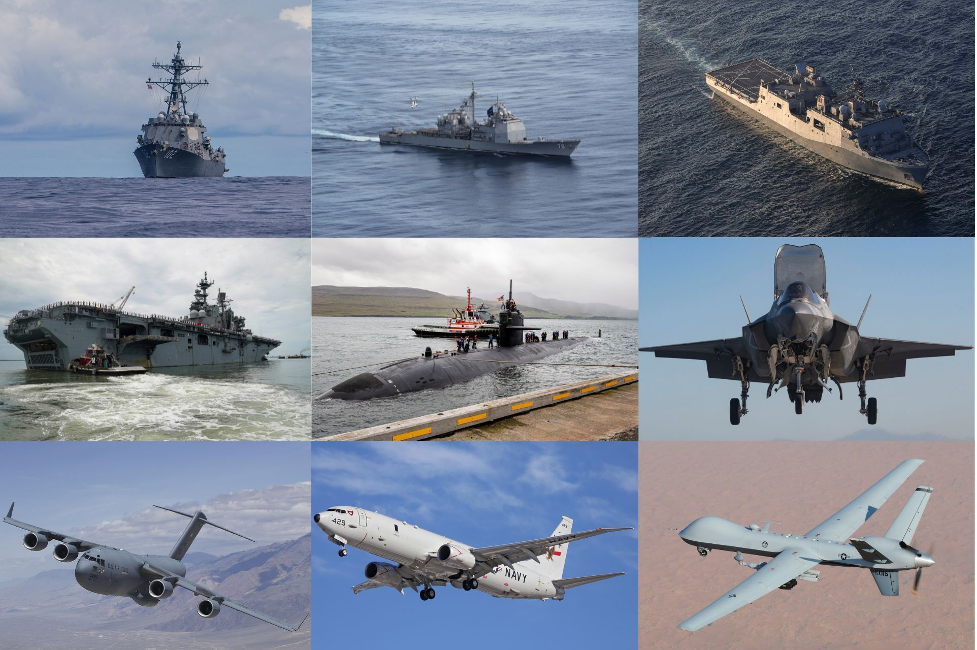
To date the US Navy has mobilized elements of an Amphibious Ready Group (ARG) from the Iwo Jima — especially the LHD Iwo Jima and the LPDs San Antonio and Fort Lauderdale — together with more than 2,000 Marines from the 22nd Marine Expeditionary Unit (MEU), three Arleigh Burke‑class destroyers and (likely) an attack submarine. Since the end of summer 2025, the US military presence in the Caribbean has evolved into a broad deployment encompassing all dimensions of naval and air power. Washington has simultaneously deployed surface combatants, a nuclear‑powered attack submarine, an amphibious group and an advanced air element. Together these components offer a full capability set: long‑range strikes with Tomahawk cruise missiles, forcible movement of troops via amphibious ships, air support from fifth‑generation fighters and surveillance strengthened by unmanned aerial vehicles and maritime patrol aircraft. The result is an integrated posture capable of high‑intensity operations while maintaining a persistent deterrent presence.
The core of the mission lies with the surface fleet. Three Arleigh Burke‑class destroyers — USS Gravely (DDG 107), USS Jason Dunham (DDG 109) and USS Sampson (DDG 102) — are operating in the Caribbean. Equipped with the Aegis combat system, these destroyers combine air‑defense, anti‑submarine and anti‑surface capabilities. Each carries more than 90 vertical launch system (VLS) cells configured for SM‑2, SM‑6, ESSM and Tomahawk missiles. Their strength is bolstered by the cruiser USS Lake Erie (CG 70), which carries more than 120 VLS cells and provides saturation firepower and deep‑strike capability against land targets. The Los Angeles‑class nuclear‑powered attack submarine USS Newport News (SSN 750) adds a covert but decisive element. It can launch nearly 40 Tomahawk missiles in addition to Mk‑48 torpedoes and provides undersea surveillance.
US forces deployed in the Caribbean include warships, a nuclear attack submarine, amphibious ships, F‑35B fighters, P‑8 Poseidon aircraft, MQ‑9 Reaper drones and Marine helicopters. The amphibious element is equally important. The Wasp‑class amphibious assault ship USS Iwo Jima (LHD 7) serves as an aviation platform with a flight deck capable of hosting F‑35B fighters, CH‑53E Super Stallion heavy‑lift helicopters, MV‑22 Osprey tiltrotors and AH‑1Z Viper attack helicopters. In addition, USS San Antonio (LPD 17) and USS Fort Lauderdale (LPD 28) provide lift for troops, armored vehicles and heavy equipment. The 22nd Marine Expeditionary Unit’s roughly 4,000 sailors and Marines form an assault force able to seize coastal areas, execute noncombatant evacuations or provide humanitarian assistance.

The arrival of five F‑35B Lightning II aircraft in Puerto Rico marks an important step: these stealth fighters provide air superiority, precision strike and intelligence collection through advanced sensors. They complement the AV‑8B Harrier II jets still in service with the Marines. The deployment also includes P‑8A Poseidon aircraft specialized in maritime patrol and anti‑submarine warfare that can employ sonobuoys, the Mk‑54 torpedo and Harpoon anti‑ship missiles. MQ‑9 Reaper drones provide persistent surveillance over maritime areas with endurance exceeding 24 hours. For strategic mobility, KC‑135 Stratotanker and KC‑46A Pegasus aircraft extend fighter range, while C‑17 Globemaster III and C‑5M Galaxy transports deliver heavy lift.
The US Department of Defense (the Pentagon) has said it sent the Gerald R. Ford carrier strike group to US Southern Command’s area of responsibility for “counter‑drug” operations.
The Pentagon continues to present this buildup as a “counter‑drug” operation. Navy commander Admiral Daryl Caudle emphasized that the ships are operating against cartels designated as terrorist organizations. President Donald Trump confirmed that there were two strikes on vessels described as narco‑terror platforms and used the term “kinetic strike” to underline their aggressive character. According to Washington, evidence shows that these vessels were carrying cocaine and fentanyl, which forms the basis for legitimizing the use of naval forces. In Caracas, President Nicolás Maduro responded by launching Operation Independence 200, mobilizing the armed forces and militias across 284 coastal zones. The Venezuelan Air Force increased flights, including F‑16s deployed near the American destroyers. The government argues that the US presence poses an existential threat and frames the counter‑drug campaign as a pretext for regime change.
The US force expansion has also provoked international responses. Beijing condemned violations of international law and called on Washington to respect Venezuelan sovereignty. Moscow offered political support to Caracas but limited its intervention to diplomatic statements. These reactions underline the geopolitical dimension of the deployment: beyond Venezuela, it reflects great‑power competition for influence in the Western Hemisphere. The mix of multi‑mission destroyers, a heavy cruiser, a nuclear attack submarine, amphibious ships and fifth‑generation aircraft has the potential to turn the Caribbean into a high‑intensity theater. Although Washington insists there is no plan for a land invasion, the assets deployed provide a wide range of military options — from maritime blockade to precision strikes against strategic infrastructure. For Venezuela, this poses a challenge beyond its military capacity; for the United States, it is a calibrated show of force aimed at reaffirming technological superiority and operational freedom in the region.
In the week President Donald Trump escalated the Caribbean drug war by deploying the CIA against Nicolás Maduro’s regime, the Department of Justice ironically secured an indictment against John Bolton — the architect of the failed secret strategy during the first Trump administration to overthrow Maduro. The two regime‑change operations share a common figure: Marco Rubio, once Maduro’s fierce opponent as a senator. Now, as Secretary of State and National Security Advisor, Richard Grenell became the new architect of Trump’s Venezuela policy after successfully blocking Grenell’s attempt to negotiate a diplomatic settlement with Maduro. Once again, warships in the Caribbean and the CIA on the ground put regime change back on the table. What could possibly go wrong?
Trump’s tendency to turn his metaphorical war on drugs into a real war by deploying the US military dates back to his first administration, when he threatened to designate drug cartels as foreign terrorist organizations and proposed missiles to blow up drug labs in Mexico. During his last presidential campaign he said, “Drug cartels are waging war on America and now it’s time for America to declare war on the cartels.” It appears he meant it. Upon returning to office, he designated six Mexican cartels, the Salvadoran MS‑13 gang and Venezuela’s Tren de Aragua gang as Foreign Terrorist Organizations (FTOs) and ordered the Pentagon to prepare military campaign plans against them. White House officials seriously discussed military strikes against cartel leaders and infrastructure inside Mexico, but ultimately decided cooperation with the Mexican government would be more effective. Nevertheless, the unusually appointing of an experienced Special Forces officer to head the National Security Council’s Western Hemisphere Affairs office signaled that Trump remained serious about using military power in the drug fight.

Yet despite this impressive display of military capability, it seems unlikely the Trump administration is prepared to invade Venezuela. The forces currently deployed are not sufficient to occupy a country five times the size of Iraq — Washington’s last disastrous nation‑building effort. Moreover, Trump repeatedly promised the MAGA base there would be no “endless” foreign wars, and at a 2024 campaign rally he said he would leave “those stupid, dumb, endless war days” behind forever. Even air strikes on Iran’s nuclear facilities caused significant concern within the “America First” base. And no one has won the Nobel Peace Prize for starting wars. The next likely steps are targeted strikes against drug storage facilities, traffickers and perhaps members of the Maduro regime — the type of attacks the White House considered in February against Mexico. That could slow or even stop drug flows via Venezuela, but Venezuela is not a drug producer: Colombia is the drug producer, and if traffickers cannot send their drugs through Venezuela they will send them through Mexico or via Pacific‑coast homemade “narco‑submarines.” The obvious futility of trying to stop drug trafficking by starting a covert or overt war with Venezuela suggests the true aim is political — namely, to effect regime change.
Could CIA covert agents accomplish this? Where they have succeeded (Iran 1953, Guatemala 1954, Chile 1973), the key was turning the military against the civilian government. That is unlikely in Venezuela. The network known as the “Suns Cartel” — a loose group of military officers profiting from a variety of criminal enterprises including cooperation with Colombian cocaine traffickers — complicates matters. Regime change in Caracas, especially the installation of an opposition government led by María Corina Machado and her allies, would pose a serious threat to the interests of the military. They could align with Maduro, but if the regime and armed forces’ infrastructure remain intact, nothing will change. A CIA coup attempt already failed once. In 2019, at the height of popular opposition to Maduro and when Washington backed opposition leader Juan Guaidó as the legitimate president, the “Liberty Operation” was a plan to split the military and trigger the regime’s collapse. But the plan collapsed when not even a significant military unit defected.
If the US invasion of Panama, codenamed “Operation Just Cause,” was meant to compensate for past disasters in Vietnam and earlier interventive challenges in Central America, then it is not hard to see a potential invasion of Venezuela as an attempt to make up for US military failures in Iraq and Afghanistan. There are some similarities between the invasion of Panama and a possible attack on Venezuela. Like Panama in 1989, Venezuela does not represent a proximate security threat to the United States despite Mr. Trump’s rhetoric. Mr. Maduro is not solely responsible for migration to the US or for drug flows to the United States. Rather, a possible attack on Venezuela — like Operation Just Cause — looks partly like a preferred preventive war launched to appease local Republican constituencies represented by Secretary of State Marco Rubio, who has long advocated regime change, and to distract critics of President Trump’s domestic policies.
US interventions in Latin America, regardless of their stated reasons, inflict severe suffering on ordinary people caught in the path of American forces. In 1989 the circumstances aligned with America’s objective…
REFERENCES
[1] https://warontherocks.com/2025/10/optimism-for-gaza-is-based-on-shaky-assumptions/
[2] https://www.csis.org/analysis/russias-war-ukraine-next-chapter
[3] https://www.economist.com/finance-and-economics/2025/10/23/will-americas-new-sanctions-on-russian-oil-force-a-peace-deal
[5] https://www.economist.com/europe/2025/10/26/the-kremlins-blitz-to-make-ukraine-go-dark
[6] https://www.economist.com/briefing/2025/10/02/why-russias-micro-aggressions-against-europe-are-proliferating
[7] https://www.economist.com/leaders/2025/09/10/the-kremlins-plot-to-kill-natos-credibility
[8] https://www.bbc.com/news/articles/cn40w7g2d2zo
[9] https://www.bbc.com/news/articles/czxn00l00r6o
[10] https://www.independent.co.uk/news/world/europe/ukraine-russia-war-map-trump-putin-tuapse-drones-latest-news-b2856845.html
[11] https://www.hurriyet.com.tr/dunya/berlin-turkiyeye-daha-pragmatik-yaklasacak-almanya-ile-yeni-sayfa-43004012
[12] https://www.defenceturkey.com/tr/icerik/turkiye-ingiltere-ile-eurofighter-typhoon-savas-ucagi-alimi-icin-tarihi-anlasma-imzaladi-6372
[13] https://www.tercuman.com/analiz/rota-gokte-birlesti-eurofighterda-turk-ingiliz-is-birligi-1258
[14] https://www.yenisafak.com/yazarlar/nedret-ersanel/eurofighterin-stratejik-anlami-turkiye-ingiltere-anlasmasi-kime-mesaj-4763196
[15] https://www.barandergisi.net/turkiyenin-ingiltere-ile-imzaladigi-eurofighter-anlasmasi-dunya-basininda
[16] https://www.aa.com.tr/tr/analiz/turk-alman-iliskilerinde-stratejik-ortaklik-yeniden-mi-basliyor/3730433
[17] https://www.dw.com/en/conflict-in-the-caribbean-how-far-will-trump-go/a-74578399
[18] https://www.theguardian.com/world/2025/nov/01/trump-maduro-venezuela-coups
[19] https://www.worldpoliticsreview.com/gaza-israel-trump-peace-plan/
[20] ” Mısır’daki İsrail-Hamas dolaylı görüşmeleri hakkında neler biliniyor? “, Euronews, 7 Ekim2025, https://tr.euronews.com/2025/10/07/misirdaki-israil-hamas-dolayli-gorusmeleri-hakkinda-neler-biliniyor.
[21] ” Şarm el-Şeyh Barış Zirvesi: Bölgede yeni bir dönemin başlangıcı mı? “, Anadolu Ajansı, 14 Ekim 2025, https://www.aa.com.tr/tr/analiz/sarm-el-seyh-baris-zirvesi-bolgede-yeni-bir-donemin-baslangici-mi/3716600.
[22] https://www.dw.com/tr/t%C3%BCrkiyenin-de-imza-att%C4%B1%C4%9F%C4%B1-gazze-deklarasyonunda-ne-var/a-74340937
[23] ” Reuters’tan Gazze müzakeresi analizi: “Türkiye kendini yeniden kanıtladı”-“Ankara bu ivmeyle Washington’la ilişkileri geliştirmek istiyor”, Independent, 21 Ekim 2025, https://www.indyturk.com/node/766820/d%C3%BCnya/reuterstan-gazze-m%C3%BCzakeresi-analizi-t%C3%BCrkiye-kendini-yeniden-kan%C4%B1tlad%C4%B1.
[24] Jeremy Bowen: ” Analiz: Trump’ın Gazze ateşkesindeki rolü belirleyiciydi ancak bu barışın yol haritası değil”, BBC Türkçe, 15 Ekim 2025, https://www.bbc.com/turkce/articles/cev1ydyz0zpo.
[25] Hüseyin Bahri Kurt: ” ABD-Körfez İlişkilerinde Yeni Gündem İbrahim Anlaşmaları mı? “, ORSAM, https://orsam.org.tr/yayinlar/abd-korfez-iliskilerinde-yeni-gundem-ibrahim-anlasmalari-mi/
[26] https://www.hurriyet.com.tr/dunya/abdden-israile-filistin-ayari-42995814
[27] https://uysi.org/tr/2025/10/18/sarm-el-seyhin-kirilgan-barisi-trump-doktrini-netanyahunun-ikilemi-ve-gazzenin-belirsiz-gelecegi/
[28] ABD Başkan Yardımcısı JD Vance İsrail’de: ‘Gazze ateşkesi beklenenden iyi gidiyor’, https://www.aa.com.tr/tr/dunya/abd-baskan-yardimcisi-jd-vanceten-gazzede-ateskes-suruyor-aciklamasi/3729257,
[29] https://medyascope.tv/2025/10/23/abd-israil-i-bati-seria-konusunda-uyardi-bati-serianin-ilhaki-gazzede-barisi-tehdit-ediyor/ https://tr.euronews.com/2025/10/22/abd-baskan-yardimcisi-jd-vance-israilde-gazze-ateskesi-beklenenden-iyi-gidiyor
[30] https://www.milliyet.com.tr/dunya/son-dakika-israil-medyasinda-gazzede-turk-askeri-endisesi-en-buyuk-risk-7466451
[31] https://www.sde.org.tr/haber/cumhurbaskani-erdogan-taraflarin-kabul-edecegi-adil-bir-baris-icin-katki-vermeye-devam-edecegiz-haberi-60675
[32] https://www.sde.org.tr/turkiye/cumhurbaskani-erdogan-bagimsiz-bir-filistin-devleti-kurulana-kadar-mucadelemiz-devam-edecek-haberi-60955
[33] https://www.hurriyet.com.tr/dunya/live-son-dakika-gazzedeki-kirilgan-ateskeste-kriz-israil-abd-ve-misir-arasinda-anlasmazlik-cikti-abd-baskan-yardimcisi-jd-vanceten-42991725#post-5
[34] https://harici.com.tr/gazzedeki-savas-henuz-bitmekten-cok-uzak/
[35] https://www.cfr.org/article/guide-trumps-twenty-point-gaza-peace-deal
[36] https://www.theguardian.com/commentisfree/2025/oct/30/gaza-ceasefire-war-israel-airstrike-donald-trump
[37] https://warontherocks.com/2025/10/optimism-for-gaza-is-based-on-shaky-assumptions/
[38] https://www.brainyquote.com/topics/arms-race-quotes
[39] https://www.reuters.com/business/aerospace-defense/russia-ukraine-launch-overnight-missile-strikes-after-trump-putin-summit-delay-2025-10-22/
[40] https://www.nato.int/cps/en/natohq/opinions_238380.htm
[41] https://www.euronews.com/2025/10/18/disappointment-in-ukraine-as-possibility-of-obtaining-tomahawk-missiles-remains-uncertain
[42] https://www.atlanticcouncil.org/content-series/inflection-points/dispatch-from-ukraine-the-path-to-a-durable-peace-is-emerging/
[43] https://www.bbc.com/news/articles/cnve5532v7yo
[44] https://www.bbc.com/news/articles/cn00e422yr2o
[45] https://www.theguardian.com/world/2025/oct/02/vladimir-putin-dismisses-fears-moscow-plans-attack-nato
[46] https://www.atlanticcouncil.org/blogs/ukrainealert/tomahawk-missiles-are-russias-latest-red-line-will-trump-call-putins-bluff/
[47]14 NATO ülkesinden nükleer tatbikat’’, https://harici.com.tr/14-nato-ulkesinden-nukleer-tatbikat/
[48] https://edition.cnn.com/2025/10/22/europe/russia-nuclear-drills-putin-intl
[49] https://www.themoscowtimes.com/2025/10/22/putin-oversees-nuclear-forces-drills-kremlin-a90899
[50] https://www.theguardian.com/world/2025/oct/02/us-give-ukraine-intelligence-long-range-energy-targets-russia-reports
[51] https://www.theguardian.com/world/2025/oct/26/ukraine-war-briefing-us-reportedly-mulling-further-sanctions-on-russia-that-could-hit-banking-sector
[52] https://www.dw.com/en/ukraine-updates-deadly-ballistic-missile-attack-hits-kyiv/live-74493665
[53] https://www.csis.org/analysis/russias-war-ukraine-next-chapter
[54] https://www.bbc.com/news/articles/cx2y9je4d3go
[55] https://www.bbc.com/turkce/articles/ckg37j4rypyo
[56] https://www.cnbce.com/gundem/almanya-disisleri-bakanindan-eurofighter-aciklamasi-sevkiyat-yakinda-baslayabilir-turkiye-eurofighter-alacak-mi-eurofighter-ne-zaman-turkiyeye-gelecek-h18505
[57] https://www.bbc.com/turkce/articles/cy9pjge7dgpo
[58] https://www.setav.org/korfez-turu-ve-iliskilerde-stratejik-derinlesme
[59] https://www.tercuman.com/analiz/rota-gokte-birlesti-eurofighterda-turk-ingiliz-is-birligi-1258
[60] https://www.dw.com/tr/i%CC%87mzalar-at%C4%B1ld%C4%B1-t%C3%BCrkiye-i%CC%87ngiltereden-20-eurofighter-al%C4%B1yor/a-74516120
[61] https://m5dergi.com/strateji-analiz/analiz-turk-alman-iliskilerinde-stratejik-ortaklik-yeniden-mi-basliyor/
[62] https://haber.sol.org.tr/haber/merzin-turkiye-ziyareti-almanya-silah-arkadasini-ariyor-402787
[63] https://www.pbs.org/newshour/world/the-u-s-military-has-built-up-a-large-force-in-the-caribbean-sea-heres-whats-there
[64] https://www.aljazeera.com/news/2025/11/1/trump-says-not-planning-us-strikes-on-venezuela
[65] https://www.theguardian.com/us-news/2025/oct/25/trump-venezuela-strikes-regime-change
[66] https://www.newsweek.com/trump-military-attack-venezuelan-boat-intends-redefine-war-opinion-2127827
[67] https://www.yahoo.com/news/articles/ships-us-military-deployed-caribbean-195542905.html
[68] https://en.unav.edu/web/global-affairs/tensiones-en-el-caribe-venezuela-y-el-despliegue-naval-estadounidense
[69] https://www.aa.com.tr/tr/info/infografik/48546#
[70] https://www.armyrecognition.com/news/army-news/2025/analysis-comprehensive-overview-of-us-forces-deployed-in-the-caribbean-facing-venezuela
[71] https://responsiblestatecraft.org/trump-attack-venezuela/



